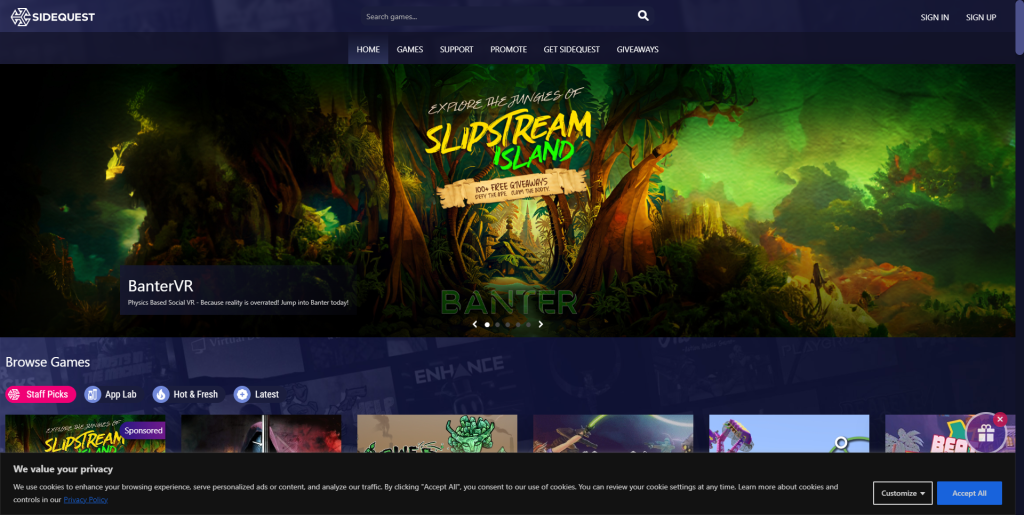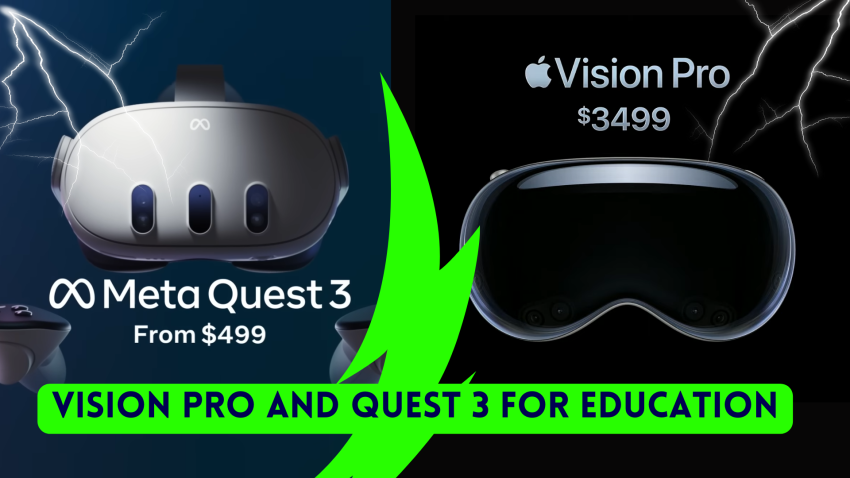
We have some big new announcements for upcoming AR/VR hardware from Meta and Apple this week. For educators, this will mean more of the same issues as educational contexts seems to be a waning consideration for the design, support, and implementation of these devices. When comparing the Apple Vision Pro and Meta Quest 3 for educational contexts, several factors come into play. The Quest 3’s affordability, scalability, and flexibility in sideloading make it a practical choice for educators aiming to integrate VR into their classrooms. Its growing ecosystem provides a rich array of educational content, enabling a diverse range of immersive learning experiences. In contrast, the Vision Pro’s higher price point, limited availability, and restrictions on sideloading may make it more suitable for specialized research or higher education institutions with specific requirements.
Virtual Reality (VR) has emerged as a powerful tool for education, allowing immersive and interactive experiences for students. Two prominent contenders in the VR market, Apple Vision Pro and Meta Quest 3, offer unique features and considerations for educators. This comparison will delve into various aspects, including price, scale, sideloading, ecosystem issues, and privacy concerns, to help educators make informed decisions about integrating VR technology into their classrooms.
Price: When considering price, the Meta Quest 3 holds a significant advantage over the Apple Vision Pro. The Quest 3 offers an affordable entry point, starting at $499 for the 128GB version, making it more accessible to educational institutions with limited budgets. In contrast, the Vision Pro’s price point of $3,499 places it out of reach for many schools, making it more suitable for specialized research or higher education institutions with larger budgets.

Scale: Scalability is a crucial factor for educators aiming to implement VR technology on a wider scale. The Meta Quest 3 shines in this aspect, offering a scalable solution that can accommodate classrooms and institutions of varying sizes. Its affordability, coupled with its growing ecosystem and availability, allows educators to deploy multiple headsets for larger student groups. In contrast, the Vision Pro’s higher price and limited availability make it challenging to scale VR experiences across classrooms or entire institutions, restricting its usage primarily to specialized research or smaller-scale applications.
Sideloading: Sideloading, the ability to load custom applications onto VR headsets, is a critical consideration for educators seeking to tailor content to their specific educational needs. Meta has historically been more flexible with sideloading, allowing educators to load apps onto the Quest headsets without the requirement of connecting individual accounts to app stores. This enables educators to easily load educational content and customize the learning experience. Apple, on the other hand, has traditionally restricted sideloading options, providing limited access through a developer testing system primarily aimed at developers rather than educators. This disparity in sideloading capabilities may impact educators’ ability to curate and expand the range of educational applications available on the VR headsets.

Ecosystem Issues: The ecosystem surrounding a VR platform plays a significant role in the availability and diversity of educational content. The Meta Quest 3 benefits from a thriving ecosystem with a wide range of educational apps and experiences. Its growing popularity has attracted developers to create educational content specifically for the platform, providing educators with an extensive library of resources to enrich their lessons. Apple Vision Pro, while backed by Apple’s robust app ecosystem, may face some limitations due to its higher price point and more specialized focus. The availability of educational content may not be as vast or diverse as on the Meta Quest 3, particularly considering the cost barrier that may deter some developers from targeting the Vision Pro specifically for educational applications.
Privacy Issues: Privacy is a critical concern for educators, as they handle sensitive student information. In this regard, Apple’s commitment to user privacy may be appealing to educators. Apple has a stronger (not perfect!) track record of prioritizing user data protection and incorporating privacy safeguards into its products. With the Vision Pro, educators can have confidence in Apple’s commitment to maintaining privacy standards. In comparison, while Meta has taken steps to enhance user privacy, including recent updates to data collection policies, its history has raised some concerns about data handling and privacy practices. Educators must carefully consider the privacy implications of VR platforms and ensure compliance with relevant regulations when integrating them into educational settings.
Ultimately, educators should carefully weigh their budgetary constraints, scalability needs, content customization requirements, and privacy considerations when selecting a VR platform for educational purposes. Both the Apple Vision Pro and Meta Quest 3 have their strengths and limitations, and educators must choose the one that aligns best with their specific educational goals and resources. In the end most educators simply need to consider more basic technology infrastructure before either of these options. AI will also be integrating into these systems soon, and that will be a whole new can of worms to deal with, probably more on the Meta side as their business model might be more susceptible to AI generating/curating content based on engagement and advertising.
| Features | Apple Vision Pro | Meta Quest 3 |
|---|---|---|
| Price | $3,499 | $499 (128GB version) |
| Scalability | Limited scalability due to high price and limited availability | Somewhat scalable, suitable for classrooms of varying sizes |
| Sideloading | Limited options for sideloading, primarily aimed at developers | Some Flexibility in sideloading, allowing educators to load custom educational content |
| Ecosystem | Robust app ecosystem, but limited availability of educational content | Growing ecosystem with a wide range of educational apps and experiences |
| Privacy | Stronger (but not perfect) commitment to user privacy and data protection | Recent updates to enhance privacy practices, but previous concerns exist |
| Accessibility | May be more suitable for specialized research or higher education institutions | Affordable entry point, making it accessible to classrooms |
| Content Diversity | Limited availability of educational content | Extensive library of educational apps and experiences |
| Technical Capabilities | Advanced display system, eye tracking, and 3D mapping | Powerful processor and high-resolution visuals |
| Data Collection | Apple’s privacy-focused approach | Recent updates to enhance privacy, but concerns remain |
| Integration with Education Software | Potential compatibility with existing Apple software and tools | Compatibility with Android, Unity3D, and other popular platforms |
If you’d like to see more information on educational projects and research that employ immersive technology, please visit https://erichawkinson.com
